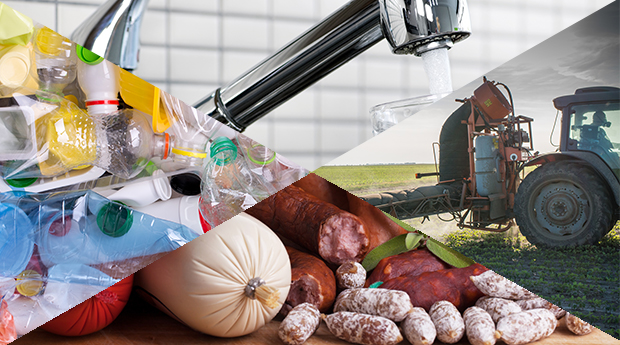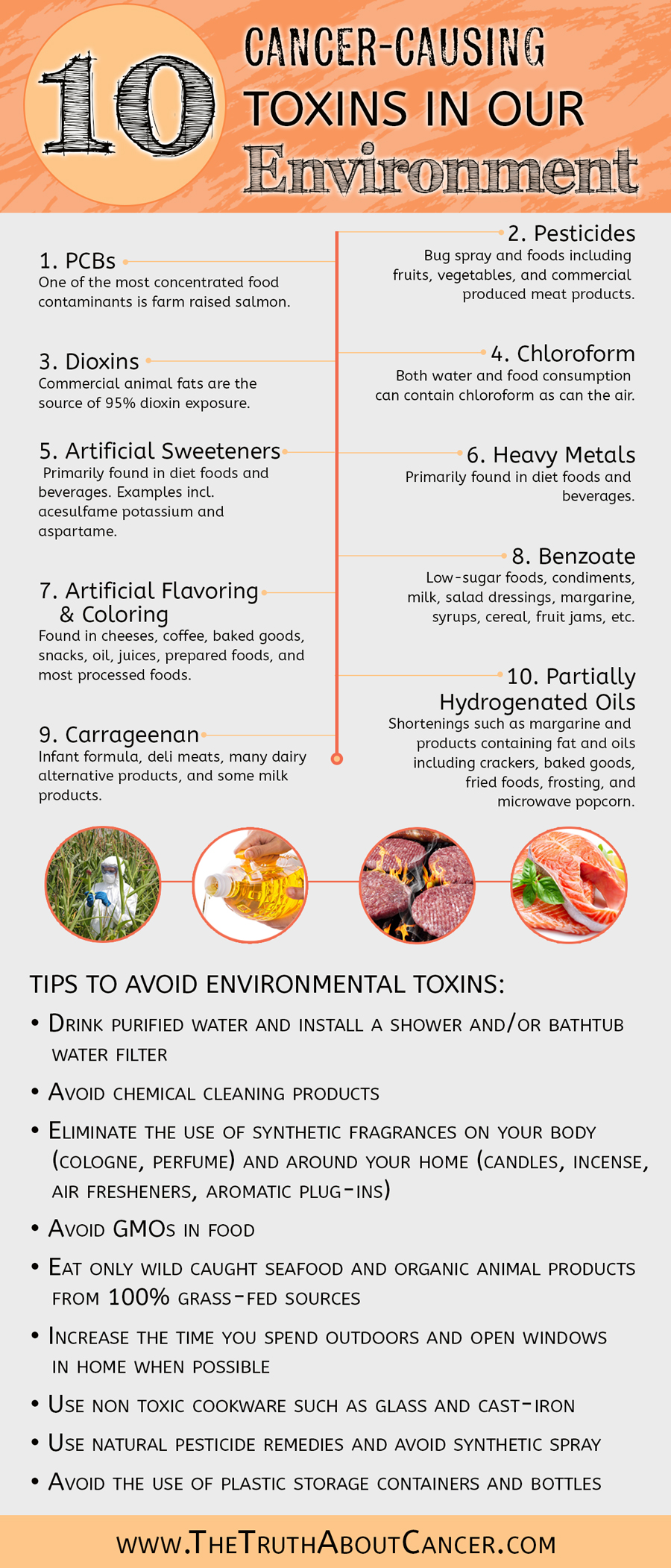Most people assume they and the environment around them are generally healthy. The sad reality is that we are living in a toxic world. Events that have occurred over the last 50 years have dramatically increased the environmental pollutants in our air, water, and soil.
Every human being is now toxic to a certain extent and as the bucket theory supports, our toxicity load increases every day. Eventually the bucket will overflow and the number of symptoms and obstacles our body struggles to manage will result in disease − oftentimes cancer.
Partly to blame is the explosion of the manufacturing industry. There is an increase in metals and hazardous chemicals like there has never been before. The United States reported in 1998 that industries were manufacturing 9,000 various chemicals in the amount of 6.5 trillion pounds. Disregarding smaller companies, major American facilities alone reported dumping 7.1 billion pounds of waste. This waste, which ended up in our air, water, and soil consisted of 650 unique industrial pollutants.
Here are 10 of the most potent and hazardous chemicals in the environment you need to: 1) be aware of, and 2) avoid as much as possible through your lifestyle choices and purchasing decisions.
1. PCBs (polychlorinated biphenyls):
The use of PCBs in industrial manufacturing has been banned for decades in the U.S. However, this organic chemical remains present in the environment and accumulates into our bodies.
Risks: Impaired fetal brain development and cancer.
Major Sources: One of the most concentrated food contaminants is farm raised salmon. PCBs from the environment are found in fish that are macerated and used as a food source for the salmon, causing bioaccumulation of the toxin.
2. Pesticides:
Alarming amounts of pesticide residue is detectable in up to 95% of foods in the United States. The Environmental Protection Agency (EPA) estimates that the following percentages of pesticides are carcinogenic:
- 90% of fungicides
- 60% of herbicides
- 30% of insecticides
Risks: Parkinson’s disease, miscarriage, birth defects, nerve damage, nutrient malabsorption, and cancer.
Major Sources: Bug spray and conventionally grown produce including fruits and vegetables, and commercially produced meat products.
3. Dioxins:
Industrial combustion processes produce chemical compounds known as dioxins. The burning of fuels from coal, oil, and wood as well as commercial and municipal waste incineration results in the synthesis of dioxin chemicals into the environment.
Risks: Reproductive and developmental disorders, skin irritations including a severe skin disease known as chloracne, excessive body hair, liver damage, and cancer.
Major Sources: Commercial animal fats are the source of 95% dioxin exposure.
4. Chloroform:
When chlorine is added to water, this chemical is formed. It is a colorless liquid that has a slightly sweet taste, non-irritating, and pleasant aroma. Chloroform is used in the production of other chemicals.
Risks: Reproductive defects, birth abnormalities, dizziness, fatigue, liver and kidney damage, headache, and cancer.
Major Sources: Both water and food consumption can contain chloroform as can the air. Avoid processed foods and filter your water.
5. Heavy Metals:
Heavy metals are extremely prevalent in the environment around us and can readily build up in soft body tissue. Some of the most concerning include mercury, aluminum, lead, cadmium, and arsenic.
Risks: Neurological disorders, Alzheimer’s disease, impaired cognitive thought, fatigue, nausea and vomiting, blood vessel damage, abnormal heart rhythm, reduced production of red and white blood cells, and cancer.
Major Sources: Pesticides, aluminum cookware, certain types of fish, vaccines, dental amalgams, some toys and products from China, old lead pipes and lead-pigment paint.
Toxic Additives in Food
Not only must we concern ourselves with avoiding chemicals that accumulate in the environment around us but we must also make ourselves aware of harmful food additives that inundate our food supply. Currently there are 3,968 FDA approved food additives that are impossible for you to remember. The following are 5 of the most toxic to your health which you should avoid.
6. Artificial Sweeteners:
These synthetic sugars stimulate the sweet receptors on our tongue by up to 7,000 times stronger than natural sweeteners. Artificial sweeteners were first discovered during a mistake in a lab decades ago but since has taken off in various forms in the marketplace. Eliminate artificial sweeteners from your diet and use healthier and natural options like honey, maple syrup, and organic green stevia.
Risks: Associated with reduced HDL “good” cholesterol and antioxidant activity, metabolic dysfunction, leukemia, brain tumors and lymphoma.
Sources: Primarily found in diet foods and beverages. Examples include acesulfame potassium and aspartame. A few popular marketed brands include Sunett, Sweet One, Equal, and NutraSweet.
7. Artificial Flavoring & Coloring:
Your exposure to artificial flavorings is almost unavoidable. Their prevalence is widespread in a variety of food products and are used to enhance the taste or mimic natural flavors. Extremely limited research has been conducted on the toxic effects of artificial flavorings, posing the question… what are the long term health consequences?
Food coloring from the presence of food dyes is also used to present a desirable color to the consumer, which mimics its natural state. Some of the most critical food colorings you should avoid include red and yellow food dyes.
Risks: Some of the known chemicals used in artificial flavoring such as alpha-diketone and diacetyl are known to cause problems like respiratory complications and may trigger fibrosis. Convincing evidence supports that artificial food colorings cause severe reactions associated with hypersensitivity, increased cancer risks, and thyroid dysfunction.
Sources: Found in cheeses, coffee, baked goods, snacks, oil, juices, prepared foods, and most processed foods.
8. Benzoate (Sodium Benzoate):
This chemical is designed as an antibacterial and antifungal agent. It is added as a food preservative and it is best to be avoided.
Risks: Benzoate creates digestive upset by suppressing digestive enzyme activity. Symptoms associated with benzoate consumption include gastrointestinal upset, headaches, and inflammatory responses such as asthma, ADHD, and hyperactivity.
Sources: Low-sugar foods, condiments, milk, salad dressings, margarine, syrups, cereal, fruit jams, etc.
9. Carrageenan:
Eliminating this food additive from your diet is critical and is especially a concern for newborns. Carrageenan is easily absorbed through the gastrointestinal (GI) tract and poses a significant harm in its metabolized forms in the body. Extracted from certain seaweeds, carrageenan is intended for use to replace fat and thicken foods and beverages.
Risks: Possible human carcinogen to cause cancer, GI disturbances including disease, and weakened immunity.
Sources: Infant formula, deli meats, many dairy alternative products, and some milk products.
10. Partially Hydrogenated Oils:
Hydrogenated oils are one of the worst offenders to our health and their prevalence is also widespread in many of the foods we eat. Hydrogenated oils stimulate inflammation in the body leading to the damage of cellular membranes and a wide array of chronic diseases to follow. its use results from manufacturer’s desire for cheap production. A compound is bombarded with hydrogen in a lab in order to create a denser oil to be used as an alternative to butter. Trans-fats should be eliminated entirely from your diet.
Risks: Contributes to diabetes, heart disease, slow metabolism, and cancer.
Major Sources: Shortenings such as margarine and products containing fat and oils including crackers, baked goods, fried foods, frosting, and microwave popcorn. Eating omega-3 rich fats found in foods produced with olive oil and coconut oil is an excellent way to avoid the dangers of hydrogenated oils.
 Avoiding Toxins in Your Environment:
Avoiding Toxins in Your Environment:
Although some food additives are generally considered safe, avoiding the 5 major food chemical groups listed above will help you promote better health today. Eating high quality whole foods sourced organically and locally is one of the best ways you can limit your exposure to many environmental toxins.
Eating a healthy diet is critical to living an anti-inflammatory lifestyle and reducing your exposure to toxins. Organic produced foods are more likely to have fewer toxins because their soil is healthier and natural pesticide strategies are used. The following tips are other strategies you should consider to preventing disease from developing in your body:
- Drink purified water and install a shower and/or bathtub water filter
- Avoid chemical cleaning products
- Eliminate the use of synthetic fragrances on your body (cologne, perfume) and around your home (candles, incense, air fresheners, aromatic plug-ins)
- Avoid GMOs in food
- Eat only wild caught seafood and organic animal products from 100% grass-fed sources
- Increase the time you spend outdoors and open windows in home when possible
- Use non toxic cookware such as glass and cast-iron
- Use natural pesticide remedies and avoid synthetic spray
- Avoid the use of plastic storage containers and bottles in favor of glass or stainless steel
Article Summary
Events over the last 50 years have dramatically increased the environmental pollutants in our air, water, and soil. As a result every human being is now toxic to a certain extent.
Here are 10 of the most potent and hazardous chemicals in the environment you need to: 1) be aware of, and 2) avoid as much as possible through your lifestyle choices and purchasing decisions.
- PCBs (polychlorinated biphenyls)
- Pesticides
- Dioxins
- Chloroform
- Heavy Metals
- Artificial Sweeteners
- Artificial Flavoring & Coloring
- Benzoate (Sodium Benzoate)
- Carrageenan
- Partially Hydrogenated Oils
Eating high quality whole foods sourced organically and locally is one of the best ways you can limit your exposure to many environmental toxins.
Here are other strategies you that will help prevent disease from developing in your body:
- Drink purified water and install a shower and/or bathtub water filter
- Avoid chemical cleaning products
- Eliminate the use of synthetic fragrances on your body (cologne, perfume) and around your home (candles, incense, air fresheners, aromatic plug-ins)
- Avoid GMOs in food
- Eat only wild caught seafood and organic animal products from 100% grass-fed sources
- Increase the time you spend outdoors and open windows in home when possible
- Use non toxic cookware such as glass and cast-iron
- Use natural pesticide remedies and avoid synthetic spray
- Avoid the use of plastic storage containers and bottles in favor of glass or stainless steel




















This is a great article, Dr. Jockers! When we eat all those type of foods, we assume that we are eating healthy stuff. In the end, we are just poisoning ourselves with all those toxins that are put in food.
With a 5 year survival rate of 2.2% for all cancers in the US, you would think Western Medicine (AMA, FDA, etc.) would take notice of the truth that conventional cancer treatment does not work. After seven years as an oncology nurse, I have never seen an oncologist change anything in a patient’s plan or what they should drink. Thank you for this web site which gives me the tools to educate my patients!
“5 year survival rate of 2.2% for all cancers in the US” That is such an outstanding lie. 5-year survival rate for all cancers combined is now approximately 68%.
Do you know if there is toxic pesticide residue danger from having commercially grown flowers sitting in vases in the home?
Sad that baby formula is toxic to your baby. Ever read the ingredient label? Partially hydrogenated oil, whey, in addition to the carrageenan. Yet, women are not encouraged to breast feed.
Cast iron could leach iron into your body which could be bad for some people. Is ceramic ok? Also, with environmental pollution and uv radiation, the outdoors might not be better. Just saying. Wish we could have the “”Good ole days”!
Anyone know what type of bath/shower filter is best for removing toxins from the water?
My protein shake contains acesulfame potassium and it also has a prop 25 warning yet thousands of customer are consuming that . Should I continue intaking it or prevent it ? Please help.
Dear Amy,
My grandfather lived to 99 and died peacefully in his sleep-he was a vegetarian and never been hospitalised aday in his life!
have you notice that with the advent of the high animal protein diet emphasis since the end of WW2,and the concurrent introduction of fast food,junk food there increasing numbers of cancers and degenerative diseases being reported-the list and classifications is endless.
yet another phenomenon that appeared around the same time was this emphasis on the need for high tech extract supplements and while the market for those extended into the hundreds of millions-it didi nothing to reverse the rates of cancers.degenerative diseases-infact i strongly believe that if at all it contributedin many ways to worsen the existing status quo by bringing a totally new number of carcinogens into play.
if this answers your questions then good on you-kindly ponder on why junk food is now cheaper and more readily available compared to good old organically grown traditional food!!
The manufacturer of hairdye chemicals state in their MSD-sheet
that it should not be applied to skin. Yet, hairdye companies include
gloves and not a protective cap, as if the dye is ‘safe’. Exposure is cancerous.
58 years ago, I started a job in the business of rebuilding automobile bumpers. These entailed everything from repairing a damaged bumper, called straightening, and welding as needed. After this, grinding the old chrome finish off of it and prepping it for the different steps involved in giving the bumper new life. Chemical solutions involved nickel plating and chrome plating. My question to this is, I recently had cancer surgery and it was attributed to the fact that I had been a smoked(socially) and nothing more. These “fad” lasted for about a year. the job at the rebuilding bumpers lasted about nine(9) years. I would like to know if being exposed to the odors of all the chemicals in the building could have caused these cancer. These surgery is oral surgery, which is very intense. These is my second bout with cancer, the other being bladder cancer. please reply.
I am surprised with all the negative facts about vaccine dangers and the billions that have been paid out in injury claims you don’t mention this much at all. You do talk about heavy metal concerns but only reference it in passing. Robert F Kennedy Jr. and others have done extensive research. Your search bar kept showing 0 results found. What goes?
Hi Ray –
Thanks for reaching out to us about this. We do agree with this and here’s a great article on this topic: https://thetruthaboutvaccines.com/vaccine-cancer-connection/
Hope this helps clarify. Blessings and love!